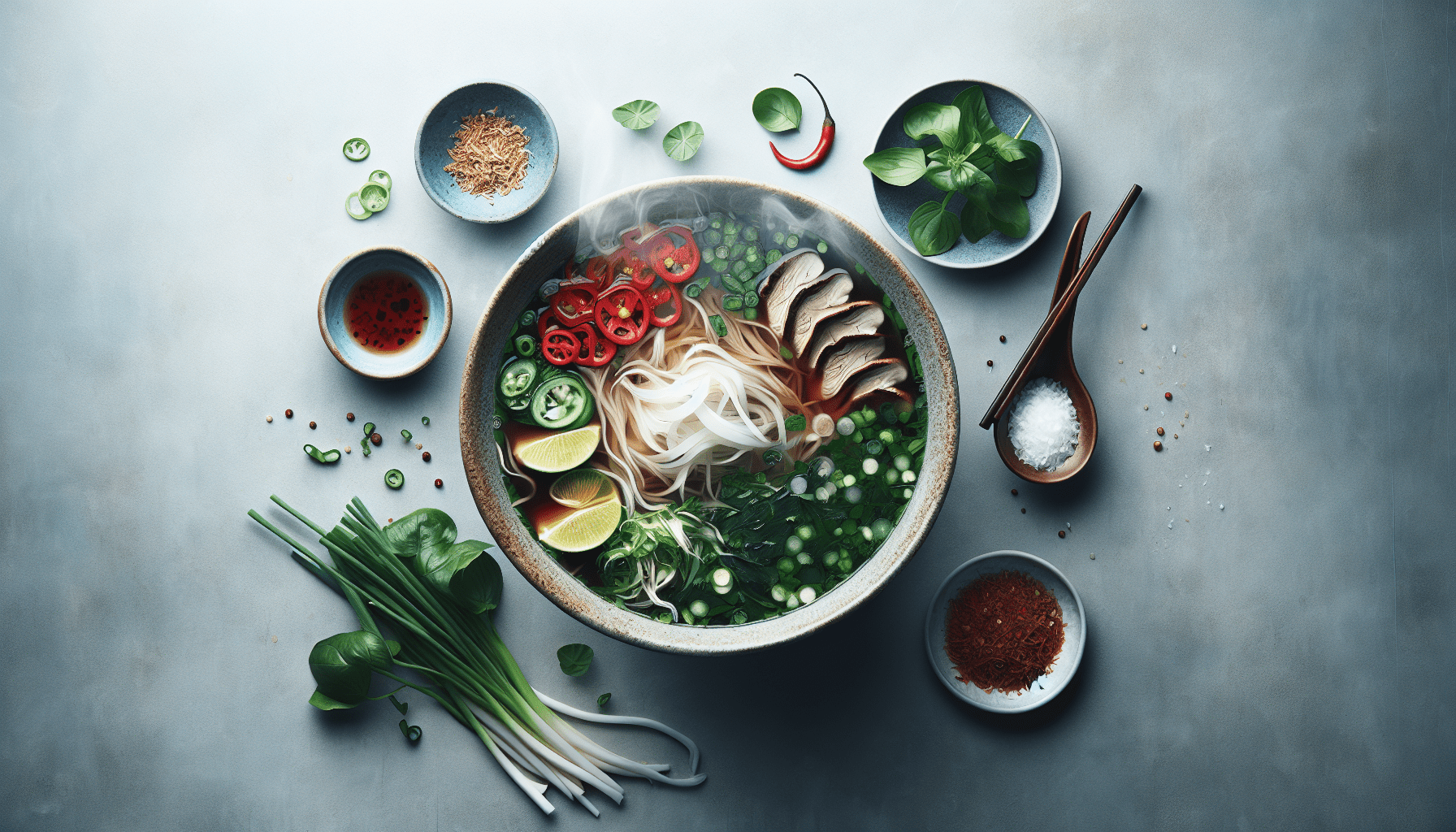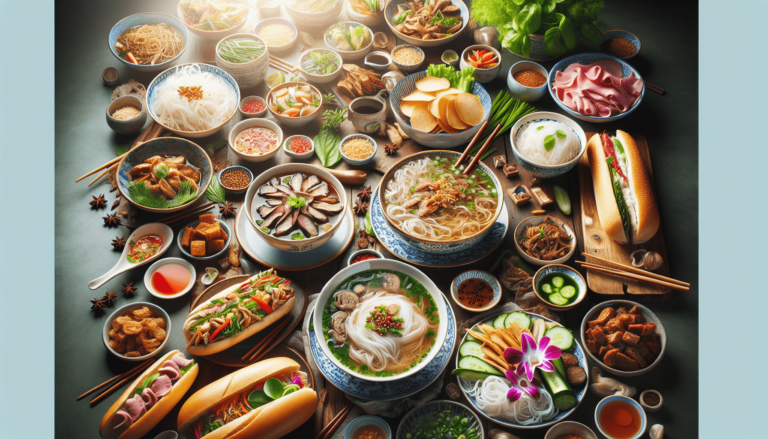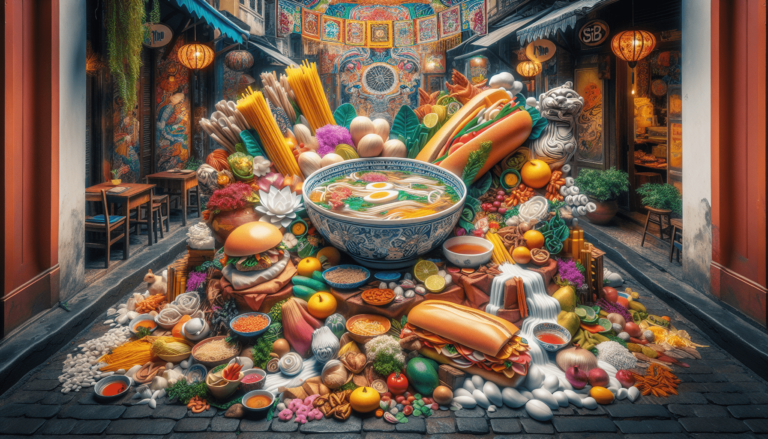Craving a steaming bowl of pho? Well, you’re in for a treat because today we’re diving into the wonderful world of this Vietnamese noodle soup. So, what are the two types of pho? Get ready to savor the knowledge as we unravel the delicious mystery behind the differences between Northern and Southern pho. From fragrant aromas to delicate flavors, this exploration will leave your taste buds tantalized and your cravings satisfied. But wait, there’s more! For an authentic and mouthwatering experience, make sure to visit one of the Eurasian Bistro locations in Pensacola. Now, let’s slurp our way into the captivating world of pho!

Understanding Pho
Pho, pronounced as “fuh,” is a traditional Vietnamese dish that has gained popularity worldwide. It is a flavorful and aromatic soup commonly served with rice noodles, herbs, and various types of meat or seafood. Pho is a staple in Vietnamese cuisine and holds significant cultural importance. Understanding the history, components, and variations of pho can deepen your appreciation for this beloved dish.
Definition of Pho
Pho can be described as a hearty and savory soup consisting of a clear broth, rice noodles, aromatic herbs, and a choice of meat or seafood. The broth is traditionally made by simmering bones, meat, and spices for several hours, resulting in a rich and flavorful base. The key components of pho, such as the broth, noodles, and garnishes, work together to create a harmonious blend of flavors.
History and Origin of Pho
The origins of pho can be traced back to Northern Vietnam during the late 19th century. While there are various theories about its exact origin, it is believed that pho was heavily influenced by both Chinese and French culinary traditions. The Chinese brought their noodle-making techniques and introduced the concept of using bones to create flavorful broths. The French, during their colonial rule, introduced beef consumption and the use of spices like star anise and cinnamon.
Significance of Pho in Vietnamese Culture
Pho holds deep cultural significance in Vietnamese cuisine and is often considered a national dish. It is commonly enjoyed as a breakfast or lunch option and is seen as a comforting and nourishing meal. Pho is often associated with familial connections and communal dining, as families and friends gather around a steaming bowl to share a satisfying meal. Its popularity has spread far beyond Vietnam, becoming a symbol of Vietnamese cuisine and a source of pride for the Vietnamese people.
Components of Pho
To fully appreciate pho, it is essential to understand its key components and the role they play in creating its unique flavors.
Key Ingredients Used in Pho
The key ingredients in pho include:
- Broth: The heart of any pho is its broth, which is typically made by simmering beef or chicken bones, along with various spices and aromatics, for several hours. This slow-cooking process allows the flavors to develop and create a rich and flavorful base.
- Rice Noodles: Pho is traditionally served with flat rice noodles that are cooked separately and added to the broth. These noodles have a delicate texture and absorb the flavors of the broth.
- Meat or Seafood: Pho can be prepared with different types of meat, such as beef (pho bo) or chicken (pho ga), as well as seafood options like shrimp or fish. The meat or seafood is typically thinly sliced and added to the soup just before serving.
- Aromatics and Herbs: Various herbs and aromatics are added to pho for extra flavor and freshness. These may include Thai basil, cilantro, lime wedges, bean sprouts, and sliced chili peppers.
The Role of Spices in Pho
Spices play a crucial role in giving pho its distinctive taste. Some of the common spices used in pho include star anise, cinnamon, cloves, coriander seeds, and cardamom. These spices infuse the broth with their warm and aromatic flavors, elevating the overall taste profile of the dish. The carefully balanced combination of spices gives pho its signature aroma and depth of flavor.
Understanding the Balance of Flavors in Pho
Pho is renowned for its harmonious blend of flavors, which can range from savory and umami to spicy and tangy. The balance of flavors in pho is achieved through the interplay of different ingredients. The savory notes come from the rich broth, while the spices bring warmth and depth. Fresh herbs and vegetables add brightness and a touch of crunch, while the noodles provide a soft and chewy texture. Achieving the perfect balance of flavors is an art form and is what makes each bowl of pho unique.
Type One: Pho Bo
Pho Bo, also known as beef pho, is one of the most common types of pho you will encounter. Here’s a closer look at what defines Pho Bo.
Defining Pho Bo
Pho Bo is a traditional Vietnamese soup made with beef broth, rice noodles, and various cuts of beef. It is characterized by its rich and fragrant broth, tender slices of beef, and an array of aromatic garnishes.
Key Ingredients of Pho Bo
The key ingredients used in Pho Bo are:
- Beef Bones: The broth for Pho Bo is typically made by simmering beef bones, such as oxtail or beef shanks, for hours to extract their flavors and nutrients. The bones contribute to the richness and depth of the broth.
- Beef Cuts: Pho Bo often includes thinly sliced beef cuts, such as brisket, flank steak, or rare beef. These cuts are added to the soup just before serving and cook gently in the hot broth.
- Rice Noodles: Similar to other types of pho, Pho Bo is served with rice noodles that are soaked and cooked separately before being added to the bowl.
Steps in Preparing Pho Bo
The process of preparing Pho Bo involves several steps:
- Broth Preparation: Beef bones, along with aromatics and spices, are simmered in water for several hours to create a flavorful broth. The broth is skimmed to remove impurities and then strained before use.
- Cooking Meat: Thinly sliced beef cuts are quickly blanched or cooked in the broth before being added to the bowls of pho to ensure they remain tender and retain their flavor.
- Noodle Preparation: Rice noodles are soaked and cooked separately, following the package instructions, and then drained.
- Assembly: In individual bowls, the cooked rice noodles are topped with the blanched beef slices and garnished with herbs, sprouts, lime wedges, and chili peppers. The hot broth is poured over the toppings, warming them through.
Regional Variations of Pho Bo
Pho Bo can vary in taste and preparation across different regions of Vietnam. In Northern Vietnam, the broth is often lighter and less seasoned, allowing the natural flavors of the beef to shine through. In contrast, Southern Vietnamese pho tends to have a more robust and flavorful broth, with stronger spices and seasonings. These regional variations reflect the diverse culinary traditions within Vietnam.
Type Two: Pho Ga
Pho Ga, also known as chicken pho, is another popular variant of this Vietnamese soup. Let’s explore what sets Pho Ga apart from other types of pho.
Defining Pho Ga
Pho Ga is a Vietnamese soup made with chicken broth, rice noodles, and tender chicken meat. It has a lighter and milder flavor profile compared to Pho Bo, making it an excellent choice for those who prefer a subtler taste.
Key Ingredients of Pho Ga
The key ingredients used in Pho Ga are:
- Chicken: Pho Ga utilizes chicken as the main meat component. The chicken may vary from boneless chicken breast to cuts with bones for added flavor.
- Chicken Broth: The broth for Pho Ga is made by simmering chicken bones, such as chicken carcasses or chicken feet, along with aromatics and spices. The resulting broth is delicate and has a comforting chicken essence.
- Rice Noodles: Like other types of pho, Pho Ga is served with rice noodles that are soaked and cooked separately before being added to the soup.
Steps in Preparing Pho Ga
The preparation of Pho Ga involves the following steps:
- Broth Preparation: Chicken bones, along with aromatics and spices, are simmered in water to create a flavorful chicken broth. The broth is then strained before use.
- Chicken Cooking: Chicken cuts, whether boneless or bone-in, are simmered in the prepared broth until fully cooked and tender. The meat is then removed from the bones or shredded before serving.
- Noodle Preparation: Rice noodles are soaked and cooked separately, following the package instructions, and then drained.
- Assembly: Cooked rice noodles are placed in individual bowls and topped with the cooked chicken slices. Pho Ga is commonly garnished with herbs, bean sprouts, lime wedges, and chili peppers. The hot chicken broth is added to the bowls, allowing the garnishes to soften and release their aroma.
Regional Variations of Pho Ga
As with Pho Bo, regional variations exist for Pho Ga as well. In the North, the chicken broth may be milder and less seasoned, while the Southern version might have a more pronounced herbal flavor. These regional differences reflect the local preferences and available ingredients, resulting in distinct interpretations of Pho Ga.

Differences between Pho Bo and Pho Ga
While both Pho Bo and Pho Ga share similarities, there are notable differences that set them apart from each other.
Differing Ingredients and Flavors
The primary difference between Pho Bo and Pho Ga lies in the choice of meat and the resulting flavors. Pho Bo features beef as the main protein, providing a richer and heartier taste. In contrast, Pho Ga utilizes chicken, resulting in a lighter and more delicate flavor profile. The choice between the two largely depends on personal preference and dietary considerations.
Distinct Preparation Methods
Despite sharing a similar preparation process, Pho Bo and Pho Ga differ in the type of bones and meats used for their broths. Pho Bo relies on beef bones, such as oxtail or beef shanks, to create a robust and meaty broth. On the other hand, Pho Ga utilizes chicken bones, such as chicken carcasses or chicken feet, to produce a lighter and more subtle broth.
Variability in Serving and Eating Style
Traditionally, Pho Bo is served with a wider array of garnishes and condiments compared to Pho Ga. This may include additional beef cuts, such as brisket or tendon, as well as condiments like hoisin sauce and sriracha. Pho Ga often features a simpler garnish selection, with common additions being herbs, lime wedges, and chili peppers. The choice to customize the bowl with additional condiments is left to personal preference.
Common Variations and Customizations of Pho
Pho is a versatile dish that allows for various permutations and customizations to suit different preferences and dietary needs.
Adding Different Meats and Seafood
While Pho Bo and Pho Ga are the most well-known variations, there are several other meat and seafood options available. Some common alternatives include Pho Tai (rare beef), Pho Dac Biet (combination of different beef cuts), Pho Hai San (seafood pho), and even vegetarian or vegan options. These variations provide an opportunity to experiment with different flavors and textures, catering to a wide range of tastes.
Vegetarian and Vegan Adaptations
Pho can be adapted to suit vegetarian and vegan diets by replacing the meat or seafood with plant-based proteins or tofu. The broth can be prepared using vegetable stock, mushrooms, and a combination of spices to create a rich and flavorful base. Additional vegetables, like bok choy and mushrooms, can be added to enhance the nutritional value and depth of the dish. Vegetarian and vegan adaptations of pho allow individuals with dietary restrictions to savor the flavors of this beloved dish.
Use of Condiments and Extra Add-ons
Pho is often served with a variety of condiments and add-ons that allow for further customization. These may include hoisin sauce, sriracha, chili oil, fish sauce, and lime juice. Each condiment adds its unique flavor and enhances different aspects of the dish. Whether it’s adding a touch of sweetness with hoisin sauce or spiciness with sriracha, these condiments allow individuals to tailor their pho according to their taste preferences.
Healthy Aspects of Pho
Pho is not only a delicious comfort food but can also offer various health benefits. It is important to understand both the positive aspects and potential considerations when enjoying this dish.
Health Benefits of Pho
Pho can be a nutritious choice due to its diverse ingredients and preparation methods. Some potential health benefits of pho include:
- Hydration: Pho’s broth-based nature helps keep the body hydrated, especially when enjoying it with a side of fresh herbs, vegetables, and sprouts.
- Rich in Nutrients: Pho provides a balance of proteins, vitamins, and minerals through the meat, noodles, and garnishes. It can be a source of lean protein, complex carbohydrates, and micronutrients.
- Collagen and Gelatin: The long cooking process of boiling bones in the broth releases collagen and gelatin, which are believed to support joint health, skin health, and gut health.
- Herbs and Vegetables: The addition of herbs, such as Thai basil and cilantro, and vegetables like bean sprouts and lime wedges, contributes to the overall nutritional value of pho.
Potential Health Risks and Considerations
While pho can be a nutritious choice, it is essential to be mindful of potential health risks and considerations:
- Sodium Content: The broth in pho can be high in sodium, especially in restaurant or pre-packaged versions. It is advisable to moderate sodium intake, especially for individuals with specific health conditions or dietary restrictions.
- Caloric Intake: Depending on the portion size and ingredients added, pho can vary in its caloric content. It is important to be mindful of overall caloric intake if you are watching your weight or have specific dietary goals.
- Food Safety: Like any other dish, proper food handling and hygiene practices should be followed to prevent foodborne illnesses. It is essential to ensure that the meat and seafood are properly cooked, and the ingredients are sourced from reputable sources.
Dietary Restrictions and Pho
Pho is a versatile dish that can be adapted to suit various dietary restrictions, such as gluten-free, dairy-free, or low-carb diets. For individuals with gluten sensitivities or celiac disease, it is important to ensure that the rice noodles used in pho are made from 100% rice flour and free from wheat or other gluten-containing grains. For those avoiding dairy, it is advisable to skip or replace any condiments or toppings that may contain dairy products. For individuals following a low-carb diet, it is possible to enjoy pho by reducing the amount of noodles and focusing on the protein and vegetable components of the dish.
How to Eat Pho Like a Local
Eating pho is not just about slurping noodles; it is a cultural experience with its own set of traditions and etiquettes. Here are some tips on how to eat pho like a local:
Proper Utensil Usage
When eating pho, it is common to use chopsticks and a spoon. The chopsticks are used to pick up noodles, meat, and herbs, while the spoon is used to sip the broth. It is customary to hold the spoon in your dominant hand and use it to guide the noodles and meat into the spoon. Remember to take your time and enjoy each bite, savoring the flavors of the broth and ingredients.
Mixing Ingredients and Layering Flavors
Pho is a customizable dish, and part of the joy is in creating your own blend of flavors. Start by tasting the broth on its own to appreciate its base flavor. Then, add in different garnishes and condiments one by one, such as herbs, sprouts, lime juice, and sauces, to create a combination that suits your taste preferences. Use the chopsticks to mix the added ingredients into the broth, allowing the flavors to meld together.
Cultural Etiquette Surrounding Pho
When enjoying pho in Vietnam, it is important to observe the cultural etiquettes:
- Sharing is Caring: If dining with others, it is customary to order a communal bowl of pho for the table, along with individual bowls of noodles and additional meat or seafood. Take turns filling the communal bowl and helping each other to ensure everyone gets a fair share.
- Soup Sip First: Prioritize sipping the flavorsome broth before diving into the noodles and toppings. The broth is considered the heart of the dish and should be appreciated as such.
- Respectful Eating: When eating pho, it is polite to avoid slurping or making loud noises. Enjoy the meal quietly, and try not to splash broth or noodles from the spoon while slurping.
Discovering Pho in Various Locations
Pho has gained popularity globally, and there are countless pho restaurants and street food stalls worldwide that offer their take on this Vietnamese classic. Here are some notable locations to discover pho:
Popular Pho Restaurants Worldwide
Major cities around the world have embraced pho, and there are numerous renowned pho restaurants to explore. These establishments have honed their recipes and techniques, ensuring an authentic and satisfying pho experience. Whether you find yourself in New York City, London, or Sydney, a quick search will reveal a range of highly-rated pho restaurants that offer a taste of Vietnam’s culinary heritage.
Pho in Vietnamese Street Food Culture
For an immersive and authentic pho experience, exploring Vietnamese street food culture is a must. In Vietnam, street vendors serve up delicious pho from steaming pots, enticing locals and tourists alike. The vibrant atmosphere, coupled with the tantalizing aroma of fresh herbs and simmering broth, create a memorable dining experience. From bustling street corners in Hanoi to narrow alleys in Ho Chi Minh City, these street food hotspots offer a glimpse into the heart and soul of pho.
Recommendation to Visit Eurasian Bistro locations in Pensacola
If you find yourself craving a taste of pho in Pensacola, Florida, a visit to Eurasian Bistro is highly recommended. Eurasian Bistro offers a diverse menu that celebrates the rich flavors and cultural fusion of Eurasian cuisine. With a dedicated pho section on their menu, diners can savor the traditional flavors of this Vietnamese dish in an inviting and trendy environment. Eurasian Bistro’s pho is prepared with care and attention to detail, ensuring a memorable dining experience.
Final Thought
Pho is more than just a bowl of soup; it represents the rich culinary heritage of Vietnam and has left an indelible mark on global cuisine. Its origins, diverse variations, and cultural significance highlight the depth of Vietnamese gastronomy. From savoring the aromatic broth to customizing the garnishes, experiencing pho is an opportunity to appreciate the artistry and complexity behind this beloved dish. So, next time you sit down to enjoy a bowl of pho, allow yourself to be transported to the vibrant streets of Vietnam and take pleasure in the comforting flavors that pho brings.







